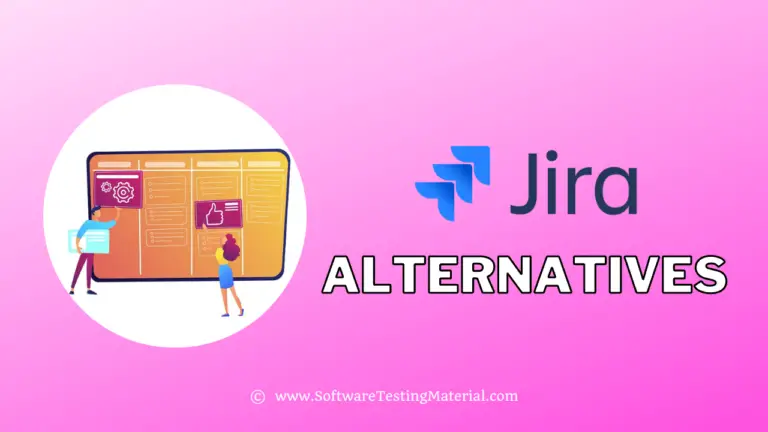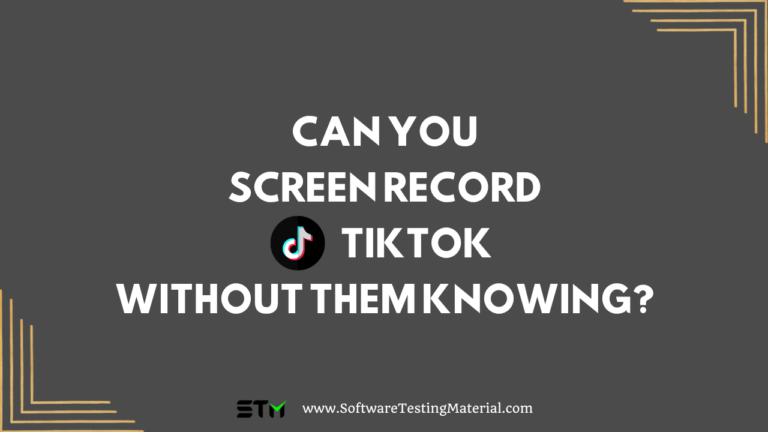Top 7 Best SSD Laptops for Ultimate Performance in 2025
Are you in search of a laptop that combines speed, reliability, and energy efficiency? Look no further! SSD laptops are the answer to your needs.
With the rise of solid-state drives (SSDs), laptop users can now enjoy faster boot times, quicker access to files, and a more responsive system overall.
Must read: How to Recover Deleted Files Mac without Software [with 5 Practical Methods]
In this blog post, we will explore the ins and outs of SSD laptops, discuss the essential features to look for, and provide our top picks for high-performance SSD laptops. So, let’s get started!
Disclaimer: Software Testing Material is reader-supported. If you purchase through a link on my site, I may earn a commission. You can read our affiliate disclosure in my affiliate disclaimer.
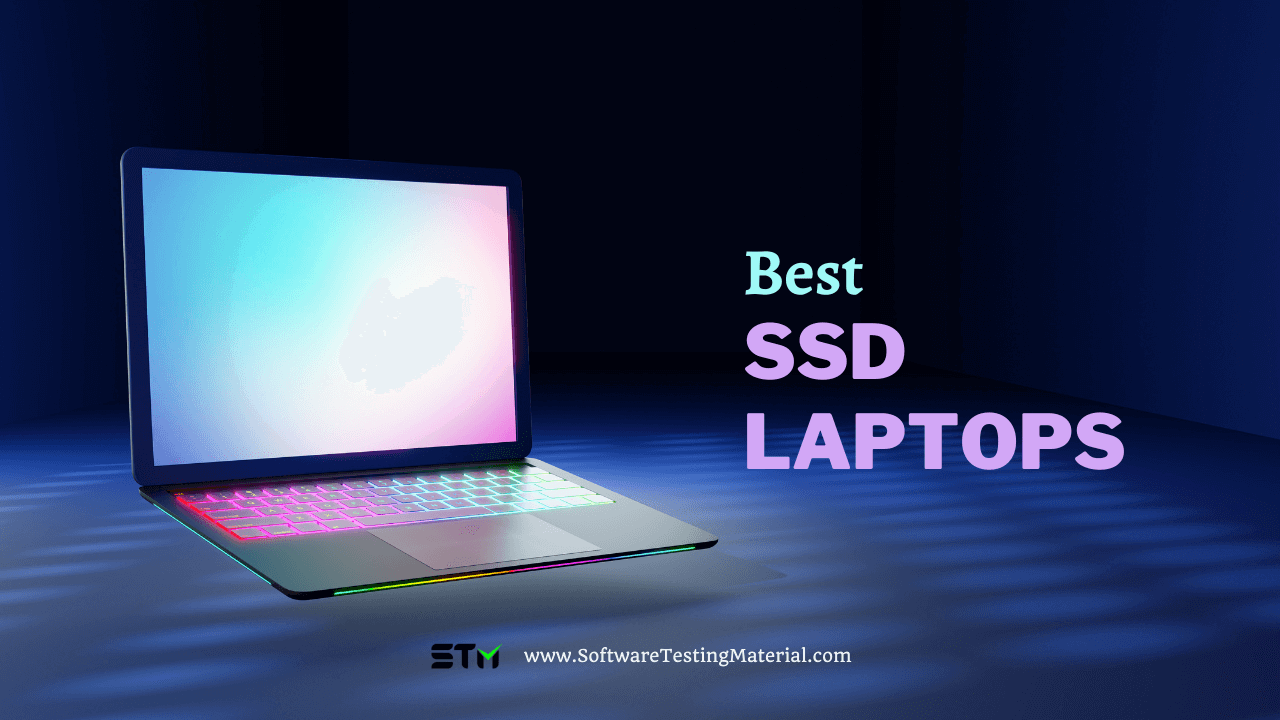
Best Solid State Drive Laptops
| Laptop | Best for |
|---|---|
| Apple MacBook Air M2 | Money, stylish design, and an amazing overall experience. |
| Acer Chromebook Spin 714 | People looking for a Chromebook |
| HP Spectre x360 | Someone looking for 2-in-1 convertible Chromebook. |
| Lenovo IdeaPad Duet 5 OLED Chromebook | People looking for detachable keyboard. |
| Asus ROG Strix Scar 17 X3D | AAA gaming. |
| MacBook Pro with M3 Pro | Photo and video editing. |
| Asus Chromebook Plus CX34 | Customers on a budget. |
| Razer Blade 18 | Gaming enthusiasts. |
| Dell XPS 13 with Intel Core i7 | Work and multitasking. |
Key Takeaways
- SSDs provide superior performance, reliability, and energy efficiency compared to HDDs.
- Factors such as processor power, graphics & display, battery life & performance should be considered when looking for an SSD laptop.
- Specialized tools and operating systems can help optimize the lifespan of an SSD laptop while backlit keyboards offer enhanced usability and encryption features to ensure data security.
What we’re looking for to select the best SSD Laptop
In our quest to find the best SSD laptop, several factors come into consideration such as Price & value, Performance, Storage, Keyboard and trackpad, Screen, Battery life, and Port selection.
- Price & Value: Price and Value are important considerations, especially for budget-conscious buyers. We aim to recommend laptops that offer the best value for money, considering not only the initial cost but also the long-term benefits of investing in a reliable and high-performing laptop with an SSD.
- Performance: In terms of Performance, we look for laptops with fast read and write speeds, as well as a good combination of processor, RAM, and SSD. For the best experience, we recommend laptops with at least 8GB of RAM and an Intel Core i5 or higher processor. Additionally, the SSD should have a read speed of at least 500MB/s and a write speed of at least 400MB/s. An ultraportable laptop should be able to handle a standard office workload without getting too hot or noisy. And if it’s a gaming laptop, it should run today’s popular games smoothly.
- Storage: When it comes to Storage Capacity, we typically recommend laptops with at least 256GB or higher SSD storage. This is enough space for most users, allowing them to store a variety of files and applications without worrying about running out of space. However, for those requiring more storage capacity, we also consider laptops with 512GB or even 1TB SSDs.
- Keyboard and trackpad: When it comes to a laptop’s keyboard and trackpad, these two factors are the main reasons you’d choose a laptop over a tablet or smartphone. Therefore, it is imperative that they are of the highest quality, as anything less would result in a frustrating user experience.
- Screen: When it comes to the screen, we love displays that boast accurate color reproduction, impressive brightness, and razor-sharp clarity. These qualities ensure that blurry edges or visible pixels won’t distract you from your visual experience.
- Battery life: Battery life is a critical factor to consider when choosing a laptop. In certain categories, it holds even greater significance than in others. However, we understand that most shoppers opt for a laptop over a desktop due to the freedom it offers to work without being plugged in. Therefore, battery life is an aspect that we absolutely consider and prioritize.
- Port selection: Having more number of ports is advantageous and preferable.
By balancing these factors, we aim to provide our clients with the best recommendations that meet their specific needs and budgets. With more and more laptops opting for SSDs as their primary storage option, we believe that investing in a laptop with an SSD is a wise choice for those looking for speed, and efficiency in a portable device.
If you’re in the market for a new laptop, be sure to consider one with an SSD for a better overall computing experience. Happy shopping!
Understanding SSDs in Today’s Laptops
The introduction of solid-state drives (SSDs), including most modern SSDs, has significantly improved laptop performance with their speed, reliability, and energy efficiency compared to traditional hard disk drives (HDDs).
As a result, SSD laptops have become increasingly popular.
SATA and NVMe are the two primary types of SSDs, both compatible with laptops equipped with Intel UHD Graphics, improving performance and data access speed.
Given the benefits of the best SSDs like:
- quick boot-up
- swift access to user files
- increased durability
- overall better laptop performance
It’s understandable why many laptop users are opting for SSDs.
The Rise of Solid State Drives
Solid-state drives (SSDs) have seen a significant rise in popularity due to their numerous advantages over traditional HDDs. Some of the benefits of SSDs include:
- Faster access and read/write operations
- Faster boot times
- Quicker file transfers
- Improved overall system performance
In fact, SSDs became a prevalent feature in laptops with the launch of the second generation MacBook Air in 2008. Since then, their use has expanded to laptops with various processors, including AMD Ryzen processors, to enhance performance and speed.
A significant example is the ASUS TUF Dash, a gaming laptop equipped with the latest Intel processors and Xe Graphics, offering a superb gaming experience boosted by an SSD.
SSDs vs. HDDs: Why Make the Switch?
Transitioning to an SSD laptop provides many benefits, including:
- Faster read and write speeds
- Augmented durability
- Lower energy usage
- Better data security
SSDs are more efficient than HDDs in terms of both read and write speeds, being able to read data 10 times faster and write data 20 times faster than HDDs. This makes them suitable for high-performance workloads, rapid data processing needs, and demanding tasks such as video editing and gaming.
Additionally, SSDs are more durable and can withstand more shock and vibration, making them ideal for portable devices or environments with rough handling. When it comes to laptop battery life, SSDs draw substantially less power than HDDs, resulting in increased battery life.
Types of SSDs: SATA and NVMe Explained
SATA and NVMe SSDs differ in terms of speed and interface.
While SATA SSDs are the standard type, NVMe SSDs provide enhanced performance due to their higher transfer rates and lower latency.
NVMe drives are specifically designed for SSDs, allowing for greater efficiency and scalability than the legacy SATA interface.
This provides NVMe SSDs with the capability to send and receive commands more rapidly, resulting in faster data access and improved performance.
PCIe in NVMe SSDs serves as a high-speed interface for communication between the SSD and the motherboard, allowing for faster data transfer rates than traditional SATA interfaces.
The advantages of SATA SSDs include:
- Lower cost
- Wide compatibility
- Increased energy efficiency
- Enhanced read/write speeds
- Reduced size and weight
- Greater durability and dependability.
Essential Features to Look for in an SSD Laptop
Choosing an SSD laptop involves considering various factors including SSD and RAM, processor, graphics and display, battery life, performance, connectivity, and expansion options.
The fundamental difference between Intel Core i5 and Core i7 processors in SSD laptops lies in their performance levels. Core i7 processors, being more powerful, are better equipped for tasks that require more resources, specialized applications, and high-end gaming.
NVIDIA GeForce RTX graphics cards, on the other hand, are desirable for SSD laptops due to their superior performance and advanced features, such as ray tracing, which provides a smooth and immersive gaming experience. In contrast, Radeon graphics cards offer a different set of features and performance levels, catering to various user preferences.
To achieve a balance between battery life and performance, it is essential to consider the processor, graphics, and display, as more powerful components may result in increased performance but also deplete the battery more rapidly.
Processor Power: Intel Core i5 vs. Intel Core i7
Intel Core i5 and i7 processors offer varying levels of performance, with i7 being the more powerful option. Core i7 processors are generally more powerful and offer better performance in comparison to Core i5 processors, making them better suited for resource-intensive tasks, specialized applications, and higher-end gaming.
Conversely, Intel Core i3 processors are suitable for basic tasks, while Core i5 processors are optimal for everyday use, basic computer needs, and light gaming. The Intel Core i7 processors generally offer superior performance compared to the Intel Core i5 processors for graphics and multitasking, as they have more cores and threads, providing increased multitasking capabilities and improved performance for activities such as gaming, content creation, and multimedia editing.
Graphics and Display: From Integrated to NVIDIA GeForce RTX
Integrated and dedicated graphics options can greatly impact a laptop’s display and gaming capabilities. NVIDIA GeForce RTX graphics cards offer superior performance and advanced features, such as ray tracing, which provides a smooth and immersive gaming experience. The combination of an SSD and an NVIDIA GeForce RTX graphics card allows for faster boot-up times and improved overall system responsiveness.
Integrated graphics can offer:
- Improved performance for graphics-intensive tasks, such as gaming
- The ability to execute advanced tasks like light content creation or casual gaming
- Cooler running and lower power consumption, which may help extend battery life.
Balancing Battery Life and Performance
Maintaining equilibrium between battery life and performance is key to an uninterrupted user experience. To ensure a balance between SSD performance and laptop battery life, it is recommended to:
- Optimize power settings
- Minimize background processes
- Manage indexing
- Select a power-efficient SSD
An SSD typically uses less power than a traditional hard drive, thus resulting in not only long battery life but also an even longer battery life and improved overall performance.
To optimize battery life in high-performance SSD laptops, it is recommended to:
- Adjust power settings
- Lower screen brightness
- Disable unnecessary features
- Utilize battery saver mode
- Optimize power management
- Keep the laptop cool
Top SSD Laptop review
#1. Apple MacBook Air Laptop
Best for your money, stylish design, and an amazing overall experience.
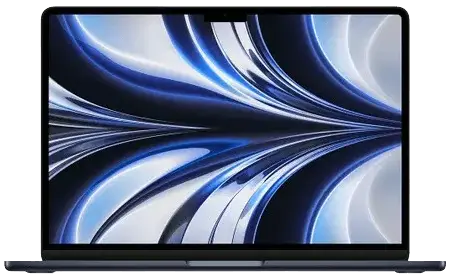
The 13-inch MacBook Air, powered by Apple’s M2 processor, is a top choice for professionals. With options for 8GB or 16GB of memory and 256GB or 512GB of storage, it offers great performance and longevity. The silent and fan-less design, along with 8 GPU cores, delivers excellent performance. Starting at $1,099, it’s a reliable and versatile laptop.
Specifications:
CPU: Apple M2 (8-core)
GPU: M2 (8- or 10-core)
RAM: 8GB, 16GB, 24GB
Storage: 256GB, 512GB, 1TB, 2TB
Display: 13.6-inch IPS display, 2560 x 1664, 60Hz, no touch option.
Dimensions: 11.97 x 8.46 x 0.44 inches
Weight: 2.7 pounds
Battery Life: Up to 18 hours
Note: You can consider the 15-inch MacBook Air for a larger screen experience. Introduced by Apple in summer 2023, it offers the same specs as the 13-inch Air in a larger chassis. With similar advantages and disadvantages, including the same processor, storage options, and two USB-C ports. The 15-inch model is slightly heavier, has a slightly higher screen resolution, and a longer battery life.
Reasons To Buy:
- The product boasts a great new design
- Impressively long battery life
- An excellent display.
Reasons To Avoid:
- It’s actually more expensive than the previous model.
Verdict: The Apple MacBook Air with the M2 chip is a superior laptop that delivers outstanding performance. Its increased memory and storage options provide excellent flexibility for diverse user needs. The fan-less and silent design enhances the user experience, and the long battery life ensures productivity is not compromised. The price point, starting at $1,099, offers considerable value for the specifications and features it brings to the table. Whether for professional or personal use, the MacBook Air M2 is a wise investment.
#2. Acer Chromebook Spin 714
Best for people looking for a Chromebook.
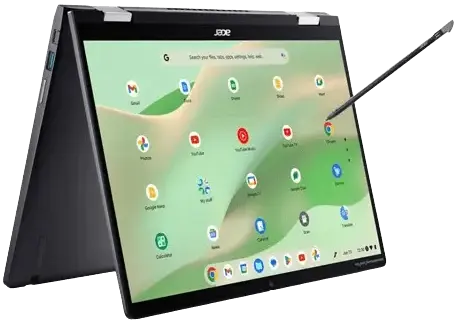
The Chromebook Spin 714 is a powerful 14-inch 2-in-1 Chromebook with fast processors and a high-resolution screen. With Thunderbolt 4 support, HDMI port, and stylus, it offers a great package. It also comes with Chromebook Plus certification, guaranteeing 10 years of software updates. A fantastic deal, especially with its current price drop to under $500.
Specifications:
CPU: Intel Core i5-1335U
GPU: Intel Iris Xe
RAM: 8GB
Storage: 256GB NVMe SSD
Display: 14-inch IPS, 1920 x 1200, multitouch
Dimensions: 12.31 x 8.82 x 0.71 inches
Weight: 3.1 pounds
Battery Life: Up to 10 hours
Reasons To Buy:
- 2 Thunderbolt 4 ports
- 1080p camera
- Stylus
- 10 years of software updates.
Reasons To Avoid:
- No microSD slot
- Battery life
#3. HP Spectre x360
Best for someone looking for 2-in-1 convertible Chromebook.
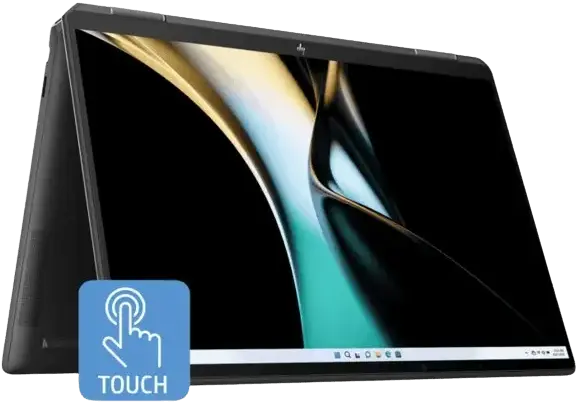
The HP Spectre x360 13.5 is a stunning and well-built machine with a premium look and feel. It offers a vibrant OLED screen, comfortable keyboard, and practical port selection. The performance is fast and reliable, making it a sleek and beautiful device. However, the battery life on the OLED model is not impressive, so consider your priorities when configuring.
Specifications:
CPU: Intel Core i5-1335U, i7-1355U
GPU: Intel Iris Xe
RAM:16GB, 32GB
Storage: 512GB, 1TB, 2TB
Display: 13.5-inch IPS, 60Hz, 1920 x 1280 / OLED, 3000 x 2000, touch option
Dimensions: 11.75 x 8.67 x 0.67 inches
Weight: 3.01 pounds
Battery Life: Up to 10 hours
Reasons To Buy:
- Built quality
Reasons To Avoid:
- Battery life
#4. Lenovo IdeaPad Duet 5 OLED Chromebook
Best for people looking for detachable keyboard.
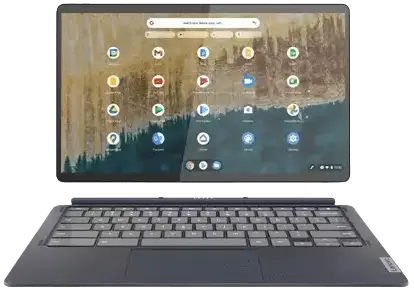
The Lenovo IdeaPad Duet Chromebook 5 is an excellent ultra-low price laptop that combines versatility and performance. With a detachable keyboard and a tablet-like design, it offers both laptop and tablet functionality. The 1080p OLED display delivers exceptional image quality. It performs smoothly for web browsing, video streaming, and basic productivity tasks. While the battery life is slightly shorter compared to the previous model, it still offers an impressive 16 hours. Overall, it provides great value for money among Chromebooks and 2-in-1 laptops.
Specifications:
CPU: Qualcomm Snapdragon 7c Gen2
GPU: Integrated Qualcomm® Adreno™ Graphics
RAM: 8GB LPDDR4X 2133MHz
Storage: 128GB eMMC Flash storage
Display: 13.3″ FHD, OLED, 1920 x 1080, touchscreen
Dimensions: 7.2mm x 186.8mm x 305.9mm / 0.28″ x 7.35″ x 12.04″
Weight:1.5lbs
Battery Life: Up to 15 hours
Reasons To Buy:
- Awesome battery life
- Stunning display
Reasons To Avoid:
- Need to purchase the stylus seperately.
#5. Asus ROG Strix Scar 17 X3D
Best for AAA gaming.
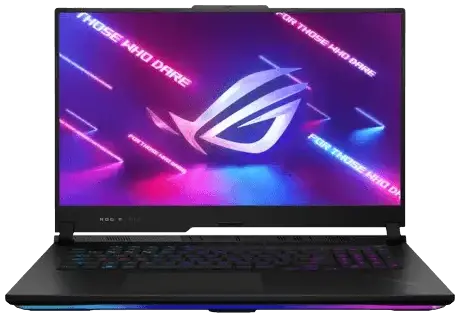
The ROG Strix Scar 17 X3D is a powerful gaming laptop featuring an AMD Ryzen 9 7945HX3D processor, Nvidia RTX 4090 GPU, and impressive specifications like 32GB RAM, 1TB storage, and a 240Hz 1440p screen. It delivers exceptional performance, outperforming laptops with similar graphics cards and Intel CPUs. With its large size and bold design, it’s a top-tier gaming laptop that can handle AAA titles at high framerates. While it has drawbacks like a mediocre webcam, poor battery life, and high cost, it sets a new standard for gaming laptops.
Must read: How to become a game tester
Specifications:
CPU: AMD Ryzen 9 7945HX3D
GPU: Nvidia Geforce RTX 4090
RAM: 32GB
Storage: 1TB
Display: 17-inch IPS QHD, 240Hz display, 3ms, 300 nits, 100 percent DCI-P3
Dimensions: 15.55 x 11.1 x 1.11 inches
Weight: 6.51 pounds
Battery Life:
Reasons To Buy:
- Performance
- A keyboard with exceptional per-key RGB lighting
- You can experience gaming with an exceptional battery life
Reasons To Avoid:
- Battery life
- Expensive
#6. MacBook Pro with M3 Pro
Best for photo and video editing.

The 16-inch MacBook Pro is Apple’s largest laptop designed for creators and power users. It features the latest M3 Pro and M3 Max chips, offering an impressive battery life of up to 22 hours and configurations up to 128GB of RAM. With its powerful processors and impressive display, the MacBook Pro is ideal for intensive creative work. The 14-inch model is also available with M3 Pro or M3 Max processors. In terms of performance, the MacBook Pro outperforms other laptops in benchmarks and offers exceptional battery life. Pricing starts at $1,999 for the 14-inch model and $2,499 for the 16-inch model.
Specifications:
CPU: M3 Pro, M3 Max
GPU: M3 Pro, M3 Max
RAM: 18GB – 36GB (M3 Pro), 36GB – 128 GB (M3 Max)
Storage: 512GB, 1TB, 2TB, 4TB, 8TB
Display: 14.2 / 16.2-inch Liquid Retina XDR, 3024 x 1964 / 3456 x 2234, adaptive refresh up to 120Hz, no touch option
Dimensions: 12.31 x 8.71 x 0.61 / 14.01 x 9.77 x 0.66 inches
Weight: 3.5 / 4.7 pounds (M3 Pro), 3.6 / 4.8 pounds (M3 Max)
Battery Life: Up to 24 hours
Reasons To Buy:
- The product boasts a great new design with extra ports compared to Mac Book Air
- Impressively long battery life
- An excellent display
Reasons To Avoid:
- Expensive
#7. Asus Chromebook Plus CX34
Best for customers on a budget.

The Asus Chromebook Plus CX34 is an affordable and reliable Chromebook with a 12th-gen Intel Core i3 processor, 8GB of RAM, and 128GB of storage. With a 1080p screen, good keyboard, and decent battery life, it’s a great choice for those on a budget. Plus, it comes with 10 years of software updates. Don’t settle for a less powerful Chromebook when you can have the Chromebook Plus CX34.
Specifications:
CPU: Intel Core i3-1215U
GPU: Intel UHD
RAM: 8GB
Storage: 128GB UFS, 256GB UFS, 512GB M.2 2280 NVMe™ PCIe® 4.0 SSD
Display: 14-inch IPS, 1920 x 1080, 60Hz, no touch option
Dimensions: 12.9 x 8.4 x 0.74 inches
Weight: 3.17 pounds
Battery Life: Up to 10 hours
Reasons To Buy:
- Excellent look and build
- 1080p screen
- 10 years of software updates
Reasons To Avoid:
- Battery life
- The touchpad feels a bit stiff
#8. Razer Blade 18
Best for gaming enthusiasts.

The Razer Blade is a high-performance gaming laptop equipped with the NVIDIA GeForce RTX 4080 graphics, delivering optimal performance. It boasts a QHD+ 18″ display for an immersive gaming experience, a 5 MP webcam for clear video calls and streaming, and 6 speakers with THX Spatial Audio. Powered by Intel 13th Gen Core i9 HX processors, the Razer Blade offers top-notch gaming performance.
Specifications:
CPU: 13th Gen Intel Core i9 Processor (24-core) i9-13950HX, 1.8 GHz with Turbo Boost up to 5.5 GHz, with 24 MB of Cache.
GPU: NVIDIA® GeForce RTX™ 4060 (8GB GDDR6 VRAM), 4070 (8GB GDDR6 VRAM), 4080 (12GB GDDR6 VRAM), 4090 (16GB GDDR6 VRAM)
RAM: 16 GB DDR5-5600MHz, 32 GB DDR5-5600MHz
Storage: 1 TB SSD (M.2 NVMe PCIe 4.0 x4), 1 TB + 1 TB (2 TB) PCIe® 4.0 NVMe™ M.2 SSD
Display: 18″ QHD+ 240 Hz, 16:10 (2560 x 1600)
Dimensions: 21.90 mm x 275.40 mm x 399.90 mm
Weight: 6.80 lbs
Battery Life: Up to 6 hours
Reasons To Buy:
- Top-notch gaming performance
Reasons To Avoid:
- Battery life
#9. Dell XPS 13 with Intel Core i7
Best for work and multitasking.
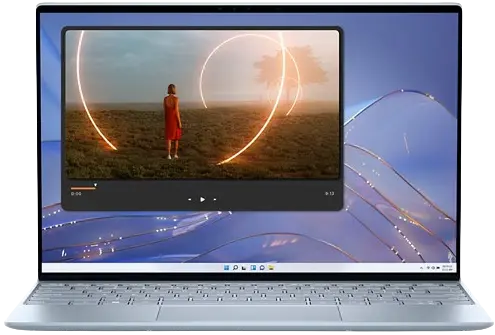
The Dell XPS is a top pick for work, featuring a powerful Intel Core i7-1065G7 processor, 16GB of RAM, and 512GB of storage. The Intel Core i7 processor is advantageous for multitasking due to its increased processing power, enabling it to handle multiple tasks concurrently. The SSD in the Dell XPS with Intel Core i7 improves work performance by providing faster data access and transfer speeds, resulting in quicker boot-up times, faster application launching, and smoother file access.
With a combination of powerful hardware and a sleek design, the Dell XPS is ideal for professionals who demand top performance and versatility.
Specifications:
CPU: 12th Gen Intel® Core™ i7-1250U
GPU: Intel® Iris® Xe Graphics
RAM: 16 GB: LPDDR5, 5200 MT/s
Storage: 512 GB, PCIe NVMe x2 NVMe, SSD integrated
Display: 34-cm. display Full HD+ (1920X1200)
Dimensions: 13.99 mm x 295.40 mm x 199.40 mm
Weight: 2.59 lbs
Battery Life: Up to 12 hours
Reasons To Buy:
- Budget-friendly
- Battery life
Reasons To Avoid:
- Slow performance compared to other top-performing laptops in the list.
Summary
In conclusion, SSD laptops offer numerous advantages over traditional HDD laptops, such as faster boot times, improved performance, and increased durability. By considering factors like processor, graphics, battery life, connectivity, and expansion options, you can find the perfect SSD laptop to suit your needs. With our top picks for high-performance SSD laptops, including the Razer Blade for gaming, Dell XPS for work, and Lenovo IdeaPad as a budget-friendly option, you’re sure to find a laptop that meets your requirements. So, why wait? Upgrade to an SSD laptop and experience the difference today!
Frequently Asked Questions: High-Performance SSD Laptops Reviewed
Are SSD laptops better?
SSDs are faster and more power efficient than HDDs, making them ideal for laptop computers. They also draw less power than hard disk drives, leading to better battery life, and are better able to withstand movement and droppage. Overall, SSDs make laptops a better choice.
What is SSD in a laptop?
A solid-state drive (SSD) is a type of storage device used in computers, which stores persistent data on solid-state flash memory. This non-volatile storage media offers many advantages over traditional hard disk drives (HDDs), such as faster access times and improved durability. SSDs are becoming increasingly popular for use in laptops due to their superior performance.
Which SSD is best for my laptop?
For your laptop, the best SSD of 2024 is the Samsung 870 QVO. Its large capacity, high speed, and reliability make it an ideal choice.
Is 256 GB SSD enough for a laptop?
256GB of internal storage is usually enough for most people who don’t store a lot of large files locally. It provides ample space to save documents, programs, and other data without taking up too much of your laptop’s capacity.
Are SSD laptops suitable for gaming?
Yes, SSD laptops are suitable for gaming, providing faster data access and transfer speeds with reduced loading times and improved performance. High-end laptops like the Razer Blade come equipped with powerful NVIDIA GeForce RTX graphics cards, allowing for a better gaming experience.
Which is better to upgrade, RAM or SSD?
Think of RAM and SSD as two helpers for your computer. RAM is like a quick-thinking helper who handles many tasks at once. The more RAM you have, the more tasks your computer can do without slowing down. Upgrading RAM makes your computer faster when you’re running lots of programs at the same time.
On the other hand, an SSD is like a super-organized helper who can quickly find and give you files you need. Replacing your old hard drive with an SSD makes your computer start up faster and open files quicker. It also helps with loading games or heavy programs.
So, both upgrading RAM and SSD can make your computer better. If you’re often running lots of programs at the same time, more RAM could be helpful. If your computer is slow to start up or load files, an SSD could make a big difference. But remember, SSDs are usually more expensive and they don’t last forever. So, always back up your files and plan to replace your SSD every few years.
Is 512 GB SSD good for laptops?
512 GB is considered to be a decent amount for most users. This amount of space allows for storing a significant number of files, including documents, photos, music and videos. It’s also sufficient for running multiple applications and programs on your laptop without experiencing any major slowdowns or performance issues.
Is 512 GB SSD faster than 256 GB SSD?
Yes, a 512 GB SSD is faster than a 256 GB SSD. This is because the more storage capacity you have on an SSD, the more space there is for data to be spread out. This results in faster read and write speeds as well as improved overall performance. Additionally, larger capacity SSDs typically have better components and technology which contribute to their speed and efficiency. So if speed is a top priority for you, it’s worth investing in a 512 GB SSD over a 256 GB one.
Can you upgrade from 256 GB to 512 GB SSD?
Upgrading your laptop’s SSD to a larger capacity offers increased storage and improved performance. It can extend the lifespan of your laptop and provide durability. SSDs are now more affordable and accessible. Consider your needs and budget when making a decision. Happy upgrading!
Related posts:


